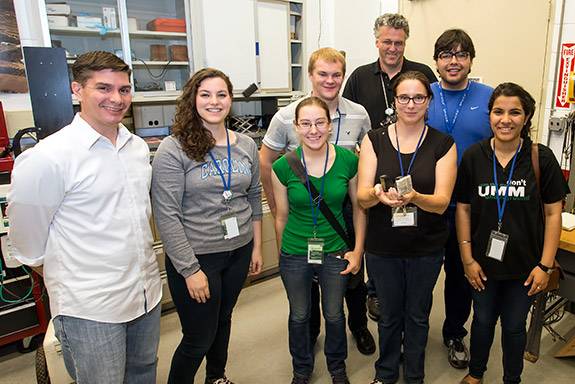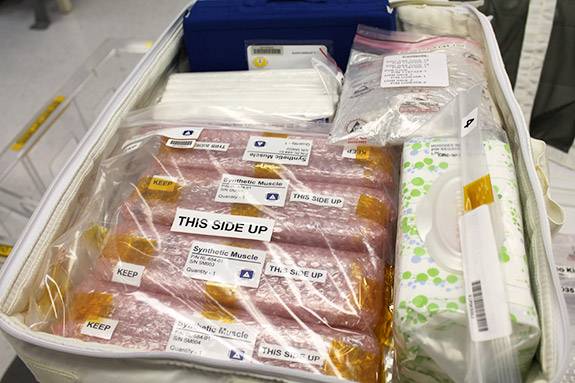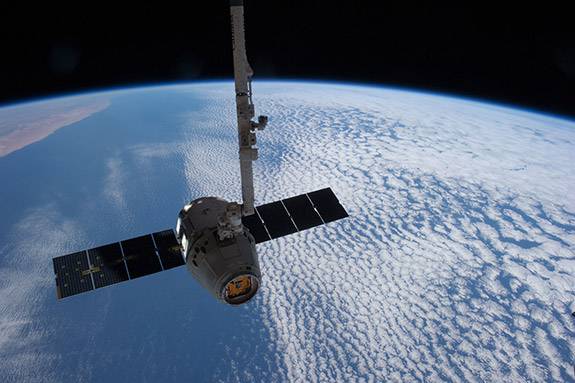Lenore Rasmussen's dream of developing a synthetic muscle that could be used to make better prosthetic limbs and more responsive robots will literally become airborne at 4:33 p.m. on Monday, April 13, when her experiment will rocket off to the International Space Station from Cape Canaveral in Florida.
Rasmussen, a synthetic polymer chemist and founder of Ras Labs, has worked closely with researchers and engineers at the U.S. Department of Energy's Princeton Plasma Physics Laboratory (PPPL) to develop the material's ability to adhere to metal. The Synthetic Muscle™ could be used in robotics in deep space travel such as travel to Mars because of its radiation resistance.
"Based on the good results we had on planet Earth, the next step is to see how it behaves in a space environment," said Charles Gentile, a PPPL engineering and scientific staff member who has worked closely with Rasmussen. "From there the next step might be to use it on a mission to Mars."

Lenore Rasmussen, second from right, and her partner Eric Sandberg, the CEO of RAS labs, far left, pose with summer interns and Robert Hitchner, a health physics technician at PPPL, in black at back. (Photo by Elle Starkman, PPPL Office of Communications)
Early connection with PPPL
Rasmussen began working with PPPL in 2007, four years after she started Ras Labs and nine years after receiving her first patent for a synthetic muscle. The muscle is made from a gel-like material called an electroactive polymer that can potentially mimic human movement by expanding and contracting. That ability would make it very useful in robotics and in developing better prosthetic limbs.
"We can't explore space without robots," Rasmussen said. "Humans can only withstand a certain amount of radiation so that limits the time that people can be in space, whereas robots, particularly if they're radiation-resistant, can be up there for long periods of time without being replaced."
Lew Meixler, the long-time head of Technology Transfer at PPPL who retired in March, said he has enjoyed helping Rasmussen follow her quest. "That's what entrepreneurs are," he said. "They're the dreamers who devote all their time, energy and resources to follow their dreams."
Rasmussen credits PPPL with providing help and support during critical points in her project. "It was and continues to be a wonderful resource not just because of the plasma physics but the people," she said. "Charlie and Lew found ways to make things happen."

The Synthetic Muscle awaits packing for transport to the International Space Station. (Photo courtesy of Boeing/NASA)
Rasmussen solved a crucial problem at PPPL: getting the gel, which can be as soft as jelly or as hard as rubber, to adhere to the metal electrodes. Initially working with Meixler on a federal Cooperative Research and Development Agreement in the Plasma Surface Laboratory, she solved the problem by treating the metal (steel or titanium) with a plasma. This changed the metal's surface and made the gel adhere more closely to the metal.
PPPL was also involved with crucial tests of the material last summer, when the material was exposed to over 300,000 RADs of gamma radiation. That is 20 times the amount that would be lethal to a human and was equivalent to a trip from Earth to Mars and back. A second test of 45 hours was enough to be equivalent to a trip to Jupiter and beyond.
Rasmussen and Gentile found that there was no change in the strength, electroacivity or durability of the material due to the radiation although there was a slight change in color. Tests on selected samples of the material found it was not affected by extreme temperatures down to -271 degrees Celsius, which is close to absolute zero, the coldest temperature possible in the universe.
Preparing for launch
Since then, PPPL staff members have been involved in planning for the launch. This involves mapping out each detail with military precision. Several PPPL staff members, along with Rasmussen and her staff, signed the back of the metal container or coupon holding the material. "All of the people who worked on the lab signed it and the coupon will go into space," said Gentile. "So I'll be up there with Gene Roddenberry."
The Synthetic Muscle™ material will be launched on the Falcon 9, a rocket carrying the Dragon, both produced by SpaceX, which will carry 4,300 pounds of supplies and payloads including material for research experiments to the International Space Station National Laboratory. The nine-engine rocket will propel the Dragon into orbit where it will meet with the Space Station 33. Astronauts will use the station's 57-foot arm to reach out and capture Dragon at 7:15 a.m. on April 15. Additional information about the launch is available at NASA's SpaceX blog.

The Dragon spacecraft, in orbit above, and Falcon 9 rocket will carry the Synthetic Muscle into space. (Photo courtesy of NASA)
The material will be kept in a zero-gravity storage rack in the U.S. National Laboratory on the space station for 90 days. The astronauts will photograph the materials every three weeks. When the material returns to Earth in July, it will be tested and compared with identical materials that remained on Earth.
Rasmussen is also exploring whether Synthetic Muscle™ could be used as a prosthetic liner, part of a lifelong quest to develop prosthetics materials that was inspired by her childhood experience seeing farm accidents and her recent experience of being at the 2013 Boston Marathon just half an hour before the bombing. The vestigial limbs of amputees can expand and contract during the day and the Ras Labs material is designed to expand and contract so it could make prosthetics more comfortable. She recently received a grant from the Pediatric Medical Device Consortium at the Children's Hospital of Philadelphia to research this possibility.
PPPL, on Princeton University's Forrestal Campus in Plainsboro, New Jersey, is devoted to creating new knowledge about the physics of plasmas — ultra-hot, charged gases — and to developing practical solutions for the creation of fusion energy. Results of PPPL research have ranged from a portable nuclear materials detector for anti-terrorist use to universally employed computer codes for analyzing and predicting the outcome of fusion experiments. The laboratory is managed by the University for the U.S. Department of Energy's Office of Science, which is the largest single supporter of basic research in the physical sciences in the United States, and is working to address some of the most pressing challenges of our time.



